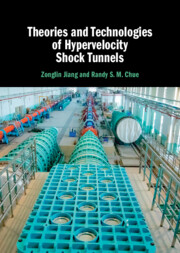Book contents
- Theories and Technologies of Hypervelocity Shock Tunnels
- Theories and Technologies of Hypervelocity Shock Tunnels
- Copyright page
- Contents
- Preface
- 1 Introduction
- 2 Shock-Wave Relations and Aerothermodynamic States
- 3 Heated Light-Gas High-Enthalpy Shock Tunnels
- 4 Free-Piston-Driven High-Enthalpy Shock Tunnels
- 5 Detonation-Driven High-Enthalpy Shock Tunnels
- 6 Theory and Methods for Long-Test-Duration Shock Tunnels
- 7 Methods for Designing High-Enthalpy Flow Nozzles
- 8 Aerothermodynamic Testing and Hypersonic Physics
- Index
- References
2 - Shock-Wave Relations and Aerothermodynamic States
- Theories and Technologies of Hypervelocity Shock Tunnels
- Theories and Technologies of Hypervelocity Shock Tunnels
- Copyright page
- Contents
- Preface
- 1 Introduction
- 2 Shock-Wave Relations and Aerothermodynamic States
- 3 Heated Light-Gas High-Enthalpy Shock Tunnels
- 4 Free-Piston-Driven High-Enthalpy Shock Tunnels
- 5 Detonation-Driven High-Enthalpy Shock Tunnels
- 6 Theory and Methods for Long-Test-Duration Shock Tunnels
- 7 Methods for Designing High-Enthalpy Flow Nozzles
- 8 Aerothermodynamic Testing and Hypersonic Physics
- Index
- References
Summary
In this chapter, the aerodynamic fundamentals for the working principles of shock tunnels are summarized. The moving waves, including expansion waves, shock waves, and contact surfaces, are introduced as the key issues and their theories are based on the unsteady one-dimensional flows in textbooks of aerodynamics. As unsteady one-dimensional moving waves are also critical for the design and operation of shock tunnels, their theories are also selected and summarized in this chapter for book completeness and readers’ convenience.
- Type
- Chapter
- Information
- Theories and Technologies of Hypervelocity Shock Tunnels , pp. 32 - 53Publisher: Cambridge University PressPrint publication year: 2023



